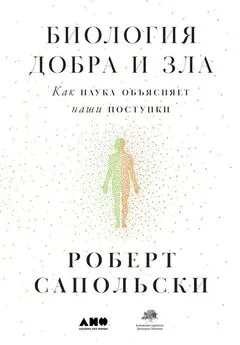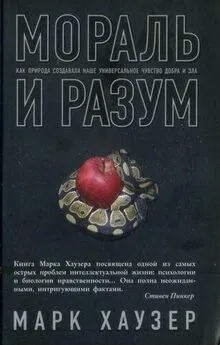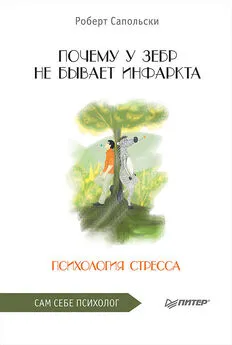Роберт Сапольски - Биология добра и зла. Как наука объясняет наши поступки
- Название:Биология добра и зла. Как наука объясняет наши поступки
- Автор:
- Жанр:
- Издательство:Альпина нон-фикшн
- Год:2019
- Город:Москва
- ISBN:978-5-0013-9051-0
- Рейтинг:
- Избранное:Добавить в избранное
-
Отзывы:
-
Ваша оценка:
Роберт Сапольски - Биология добра и зла. Как наука объясняет наши поступки краткое содержание
Биология добра и зла. Как наука объясняет наши поступки - читать онлайн бесплатно ознакомительный отрывок
Интервал:
Закладка:
395
К сноске: E. Suhay and T. Jayaratne, “Does Biology Justify Ideology? The Politics of Genetic Attribution,” Public Opinion Quarterly (2012): doi:10.1093/poq/nfs049. См. также: M. Katz, “The Biological Inferiority of the Undeserving Poor,” Social Work and Soc 11 (2013): 1.
396
E. Uhlmann et al., “Blood Is Thicker: Moral Spillover Effects Based on Kinship,” Cog 124 (2012): 239.
397
E. Pennisi, “ENCODE Project Writes Eulogy for Junk DNA,” Sci 337 (2012): 1159.
398
M. Bastepe, “The GNAS Locus: Quintessential Complex Gene Encoding Gsa, XLas, and Other Imprinted Transcripts,” Curr Genomics 8 (2007): 398.
399
Y. Gilad et al., “Expression Profiling in Primates Reveals a Rapid Evolution of Human Transcription Factors,” Nat 440 (2006): 242.
400
D. Moore, The Developing Genome: An Introduction to Behavioral Genetics (Oxford: Oxford University Press, 2015); H. Wang et al., “Histone Deacetylase Inhibitors Facilitate Partner Preference Formation in Female Prairie Voles,” Nat Nsci 16 (2013): 919.
401
I. Weaver et al., “Epigenetic Programming by Maternal Behavior,” Nat Nsci 7 (2004): 847.
402
Y. Wei et al., “Paternally Induced Transgenerational Inheritance of Susceptibility to Diabetes in Mammals,” PNAS 111 (2014): 1873; M. Anway et al., “Epigenetic Transgenerational Actions of Endocrine Disruptors and Male Fertility,” Sci 308 (2005): 1466; K. Siklenka et al., “Disruption of Histone Methylation in Developing Sperm Impairs Offspring Health Transgenerationally,” Sci 350 (2016):О 651. О противоречиях см. J. Kaiser, “The Epigenetics Heretic,” Sci 343 (2014): 361.
403
E. Jablonka and M. Lamb, Epigenetic Inheritance and Evolution: The Lamarckian Dimension (Oxford: Oxford University Press, 1995).
404
E. T. Wang et al., “Alternative Isoform Regulation in Human Tissue Transcriptomes,” Nat 456 (2008): 470; Q. Pan et al., “Deep Surveying of Alternative Splicing Complexity in the Human Transcriptome by High-Throughput Sequencing,” Nat Gen, 40 (2008): 1413.
405
A. Muotri et al., “Somatic Mosaicism in Neuronal Precursor Cells Mediated by L1 Retrotransposition,” Nat 435 (2005): 903; P. Perrat et al., “Transposition-Driven Genomic Heterogeneity in the Drosophila Brain,” Sci 340 (2013): 91; G. Vogel, “Do Jumping Genes Spawn Diversity?” Sci 332 (2011): 300; J. Baillie et al., “Somatic Retrotransposition Alters the Genetic Landscape of the Human Brain,” Nat 479 (2011): 534.
406
A. Eldar and M. Elowitz, “Functional Roles for Noise in Genetic Circuits,” Nat 467 (2010): 167; C. Finch and T. Kirkwood, Chance, Development, and Aging (Oxford: Oxford University Press, 2000).
407
Некоторые из ранних классических исследований усыновления: L. L. Heston, “Psychiatric Disorders in Foster Home Reared Children of Schizophrenic Mothers,” Brit J Psychiatry 112 (1966): 819; S. Kety et al., “Mental Illness in the Biological and Adoptive Families of Adopted Schizophrenics,” Am J Psychiatry 128 (1971): 302; D. Rosenthal et al., “The Adopted-Away Offspring of Schizophrenics,” Am J Psychiatry 128 (1971): 307.
408
Необычайный пример перепутывания младенцев вскоре после рождения и последствия этого, см.: S. Dominus, “The Mixed-Up Brothers of Bogotá,” New York Times Magazine , July 9, 2015, www.nytimes.com/2015/07/12/magazine/the-mixed-up-brothers-of-bogota.html.
409
R. Ebstein et al., “Genetics of Human Social Behavior,” Neuron 65 (2008): 831; S. Eisen et al., “Familial Influence on Gambling Behavior: An Analysis of 3359 Twin Pairs,” Addiction 93 (1988): 1375. К сноске: W. Hopkins et al., “Chimpanzee Intelligence Is Heritable,” Curr Biol 24 (2014): 1649.
410
T. Bouchard and M. McGue, “Genetic and Environmental Influences on Human Psychological Differences,” J Neurobiol 54 (2003): 4; D. Cesarini et al., “Heritability of Cooperative Behavior in the Trust Game,” PNAS 105 (2008): 3721; S. Zhong et al., “The Heritability of Attitude Toward Economic Risk,” Twin Res and Hum Genetics 12 (2009): 103; D. Cesarini et al., “Genetic Variation in Financial Decision-Making,” J the Eur Economic Association 7 (2010): 617.
411
K. Verweij et al., “Shared Aetiology of Risky Sexual Behaviour and Adolescent Misconduct: Genetic and Environmental Influences,” Genes, Brain and Behav 8 (2009): 107; K. Verweij et al., “Genetic and Environmental Influences on Individual Differences in Attitudes Toward Homosexuality: An Australian Twin Study,” Behave Genetics 38 (2008): 257.
412
K. Verweij et al., “Evidence for Genetic Variation in Human Mate Preferences for Sexually Dimorphic Physical Traits. PLoS ONE 7 (2012): e49294; K. Smith et al., “Biology, Ideology and Epistemology: How Do We Know Political Attitudes Are Inherited and Why Should We Care?” Am J Political Sci 56 (2012): 17; K. Arceneaux et al., “The Genetic Basis of Political Sophistication,” Twin Res and Hum Genetics 15 (2012): 34; J. Fowler and D. Schreiber, “Biology, Politics, and the Emerging Science of Human Nature,” Sci 322 (2008): 912.
413
J. Ray et al., “Heritability of Dental Fear,” J Dental Res 89 (2010): 297; G. Miller et al., “The Heritability and Genetic Correlates of Mobile Phone Use: Twin Study of Consumer Behavior,” Twin Res and Hum Genetics 15 (2012): 97.
414
L. Littvay et al., “Sense of Control and Voting: A Genetically-Driven Relationship,” Soc Sci Quarterly 92 (2011): 1236; J. Harris, The Nurture Assumption: Why Children Turn Out the Way They Do (NY: Free Press, 2009); A. Seroczynski et al., “Etiology of the Impulsivity/Aggression Relationship: Genes or Environment?” Psychiatry Res 86 (1999): 41; E. Coccaro et al., “Heritability of Aggression and Irritability: A Twin Study of the Buss-Durkee Aggression Scales in Adult Male Subjects,” BP 41 (1997): 273.
415
E. Hayden, “Taboo Genetics,” Nat 502 (2013): 26.
416
Несколько сильных критических замечаний по близнецовому методу и усыновлению: R. Rose, “Genes and Human Behavior,” Ann Rev Psych 467 (1995): 625; J. Joseph, “Twin Studies in Psychiatry and Psychology: Science or Pseudoscience?” Psychiatric Quarterly 73 (2002): 71; K. Richardson and S. Norgate, “The Equal Environments Assumption of Classical Twin Studies May Not Hold,” Brit J Educational Psych 75 (2005): 339; R. Fosse et al., “A Critical Assessment of the Equal-Environment Assumption of the Twin Method for Schizophrenia,” Front Psychiatry 6 (2015): 62; A. V. Horwitz et al., “Rethinking Twins and Environments: Possible Social Sources for Assumed Genetic Influences in Twin Research,” J Health and Soc Behav 44 (2003): 111.
417
Самые весомые работы защитников этих подходов: Кеннет Кендлер: K. S. Kendler, “Twin Studies of Psychiatric Illness: An Update,” AGP 58 (2001): 1005; K. S. Kendler et al., “A Test of the Equal-Environment Assumption in Twin Studies of Psychiatric Illness,” Behav Genetics 23 (1993): 21; K. S. Kendler and C. O. Gardner Jr., “Twin Studies of Adult Psychiatric and Substance Dependence Disorders: Are They Biased by Differences in the Environmental Experiences of Monozygotic and Dizygotic Twins in Childhood and Adolescence?” Psych Med 8 (1998): 625; K. S. Kendler et al., “A Novel Sibling-Based Design to Quantify Genetic and Shared Environmental Effects: Application to Drug Abuse, Alcohol Use Disorder and Criminal Behavior,” Psych Med 46 (2016): 1639; K. S. Kendler et al., “Genetic and Familial Environmental Influences on the Risk for Drug Abuse: A National Swedish Adoption Study,” AGP 69 (2012): 690; K. S. Kendler et al., “Tobacco Consumption in Swedish Twins Reared Apart and Reared Together,” AGP 57 (2000): 886. Томас Бушар: Y. Hur and T. Bouchard, “Genetic Influences on Perceptions of Childhood Family Environment: A Reared Apart Twin Study,” Child Development 66 (1995): 330; M. McGue and T. J. Bouchard, “Genetic and Environmental Determinants of Information Processing and Special Mental Abilities: A Twin Analysis,” in Advances in the Psychology of Hum Intelligence , ed. R. J. Sternberg, vol. 5 (Hillsdale, NJ: Erlbaum, 1989), pp. 7–45; T. J. Bouchard et al., “Sources of Human Psychological Differences: The Minnesota Study of Twins Reared Apart,” Sci 250 (1990): 223. Роберт Пломин: R. Plomin et al., Behavioral Genetics , 5th ed. (New York: Worth, 2008); K. Hardy-Brown et al., “Selective Placement of Adopted Children: Prevalence and Effects,” J Child Psych and Psychiatry 21 (1980) 143; N. L. Pedersen et al., “Genetic and Environmental Influences for Type A – Like Measures and Related Traits: A Study of Twins Reared Apart and Twins Reared Together,” Psychosomatic Med 51 (1989): 428; N. L. Pedersen et al., “Neuroticism, Extraversion, and Related Traits in Adult Twins Reared Apart and Reared Together,” JPSP 55 (1988): 950. См. также: E. Coccaro et al., “Heritability of Aggression and Irritability: A Twin Study of the Buss-Durkee Aggression Scales in Adult Male Subjects,” BP 41 (1997): 273; A. Bjorklund et al., “The Origins of Intergenerational Associations: Lessons from Swedish Adoption Data,” Quarterly J Economics 121 (2006): 999; E. P. Gunderson et al., “Twins of Mistaken Zygosity (TOMZ): Evidence for Genetic Contributions to Dietary Patterns and Physiologic Traits,” Twin Res and Hum Genetics 9 (2006): 540; B. N. Sánchez et al., “A Latent Variable Approach to Study Gene-Environment Interactions in the Presence of Multiple Correlated Exposures,” Biometrics 68 (2012): 466.
418
Доказательства того, что моно- или дихориальность являются значимой характеристикой: M. Melnick et al., “The Effects of Chorion Type on Variation in IQ in the NCPP Twin Population,” Am J Hum Genetics 30 (1978): 425; N. Jacobs et al., “Heritability Estimates of Intelligence in Twins: Effect of Chorion Type,” Behav Genetics 31 (2001): 209; M. Melnick et al., “The Effects of Chorion Type on Variation in IQ in the NCPP Twin Population,” Am J Hum Genetics 30 (1978): 425; R. J. Rose et al., “Placentation Effects on Cognitive Resemblance of Adult Monozygotes,” in Twin Research 3: Epidemiological and Clinical Studies , ed. L. Gedda et al. (New York: Alan R. Liss, 1981), p. 35; K. Beekmans et al., “Relating Type of Placentation to Later Intellectual Development in Monozygotic (MZ) Twins (Abstract),” Behav Genetics 23 (1993): 547; M. Carlier et al., “Manual Performance and Laterality in Twins of Known Chorion Type,” Behav Genetics 26 (1996): 409. Смешанные результаты: L. Gutknecht et al. “Long-Term Effect of Placental Type on Anthropometrical and Psychological Traits Among Monozygotic Twins: A Follow Up Study,” Twin Res 2 (1999): 212; D. K. Sokol et al., “Intrapair Differences in Personality and Cognitive Ability Among Young Monozygotic Twins Distinguished by Chorion Type,” Behav Genetics 25 (1996): 457; A. C. Bogle et al., “Replication of Asymmetry of a-b Ridge Count and Behavioral Discordance in Monozygotic Twins,” Behav Genetics 24 (1994): 65; J. O. Davis et al., “Prenatal Development of Monozygotic Twins and Concordance for Schizophrenia,” Schizophrenia Bull 21 (1995): 357. Доказательство против: Y. M. Hur, “Effects of the Chorion Type on Prosocial Behavior in Young South Korean Twins,” Twin Res and Hum Genetics 10 (2007): 773; M. C. Wichers et al., “Chorion Type and Twin Similarity for Child Psychiatric Symptoms,” AGP 59 (2002): 562; P. Welch et al., “Placental Type and Bayley Mental Development Scores in 18 Month Old Twins,” in Twin Research: Psychology and Methodology , ed. L. Gedda et al. (New York: Alan R Liss, 1978), pp. 34–41. Цитата из: C. A. Prescott et al., “Chorion Type as a Possible Influence on the Results and Interpretation of Twin Study Data,” Twin Res 2 (1999): 244.
Читать дальшеИнтервал:
Закладка:





![Роберт Сапольски - Игры тестостерона и другие вопросы биологии поведения [litres]](/books/1074102/robert-sapolski-igry-testosterona-i-drugie-vopros.webp)




